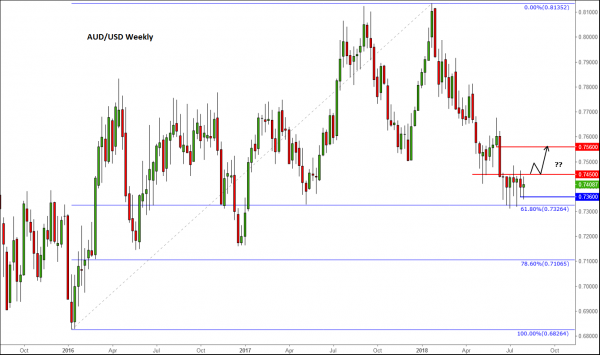After a significantly busy week, things are understandably going to be quieter next week. After all, we’ve already had three major central bank rate decisions from the likes of the BoJ, BoE and Fed and also some really important economic data, including the US nonfarm payrolls report. But despair not, we will still have two more central bank meetings to look forward to in the first half of the week and some rather important economic data at the end of the week, too.
Could the RBA turn hawkish?
The Reserve Bank of Australia (RBA) will make its rate decision on Tuesday while the Reserve Bank of New Zealand (RBNZ) will follow suit on Wednesday evening (or Thursday morning NZ time). Neither central banks are expected to make any changes, so interest rates in Australia and New Zealand are likely to remain at 1.5 and 1.75 per cent, respectively. But the Aussie and/or kiwi could move nonetheless, particularly if one or both of these central banks drop their dovish views.
While recent New Zealand data have been mixed, Australian macro figures over the past couple of months have been rather good. For example, the latest quarterly GDP came in at 1.0% in early June which was better than expected and double the figure from the previous quarter, although quarterly CPI was in line at 0.5 per cent. What’s more, retail sales have grown by 0.4% for a few months in a row now and have been better than expected on all those occasions. More importantly, Aussie employment rose sharply by 50,900 month-over-month, easily surpassing expectations. These macro pointers suggest the Aussie economy is perhaps gaining momentum and if the run can be sustained then inflation could accelerate in the months ahead. This may make the RBA a little bit more hawkish at this particular meeting. If so, then there is a good chance that the Aussie may rally.
Handful of market-moving data on Friday
Also next week, we will have a handful of very important economic data. Among them will be the quarterly GDP estimates from Japan and the UK, both on Friday. The Japanese economy is expected to have expanded by 0.3% in the second quarter compared to a contraction of 0.2% in Q1. The UK economy is expected to have expanded by 0.4% compared to its rather weak 0.2% performance in the first three months of the year. If GDP readings from these nations turn out to be stronger then the yen and pound could benefit, especially in light of the BoJ’s tweaking of QE purchases which has resulted in JGB yields rising and the BoE’s rate hike this week. Also on Friday, we will have important macro data from North America: US Consumer Price Index (CPI) measure of inflation is expected to show a 0.2% month-over-month reading, while Canadian employment figures could show another surprise after the 31,800 print last month.
Overall, next week is going to be quieter in terms of data releases, but we could still witness sizeable moves in the FX and other markets nonetheless. The handful of macro data and two central bank meetings should provide plenty of volatility for traders.
AUD/USD in focus
The AUD/USD is our featured chart for next week. We think there is a decent chance for it to break higher as recent improvement in Aussie data could see the RBA turn hawkish or at least less dovish than expected. The fact price has held above the long-term 61.8% Fibonacci level is also supporting the bullish view, although we have not yet seen a clean break of resistance, which, in this case, comes in around the 0.7450 area.


 Signal2forex.com - Best Forex robots and signals
Signal2forex.com - Best Forex robots and signals




